Berkeley Lab study shows greater potential than many other recent assessments.
Are We Understating the Potential for (and Uncertainty in) Wind Energy Cost Reductions?
Ryan Wiser, Joachim Seel, Bentham Paulos | Lawrence Berkeley National Laboratory
Prices for wind energy have hit rock bottom, thanks to technological advances and learning.
Are the opportunities for significant additional cost reductions tapped out, or are much-lower costs still possible? Recent research by Berkeley Lab suggests that some energy planners, analysts, and policymakers may be underestimating both the potential for and uncertainty in wind energy cost reductions. The consequence may be under-prediction of wind deployment, under-appreciation of the uncertainty in that deployment, and under-investment in wind R&D.
The new study, recently published in the journal Nature Energy, summarizes a global survey of 163 of the world's foremost wind energy experts to gain insight into the possible magnitude and sources of future wind energy cost reductions. It represents the largest-ever "expert elicitation" survey on an energy technology, and was led by Berkeley Lab, NREL, University of Massachusetts, and participants in the IEA Wind Technology Collaboration Programme Task 26. Though the study includes both land-based and offshore wind, here we focus exclusively on the former.
Significant Historical Cost Reductions
The cost of wind energy in the United States has declined by an order of magnitude since the industry's beginnings in the early 1980s (see Figure 3, later). As a result, and leveraged by the federal production tax credit, wind is currently being sold at rock-bottom prices. According to theU.S. DOE's Wind Technologies Market Report, wind power sales prices now average roughly $20/MWh in the large interior wind-belt, lower than the 20-year levelized expected cost of burning fuel in a natural-gas power plant (Figure 1). These $20/MWh deals equate to almost $40/MWh were the production tax credit excluded. It is important to note that these deals reflect excellent conditions, in terms of wind resource, ease of development, and supportive policies.
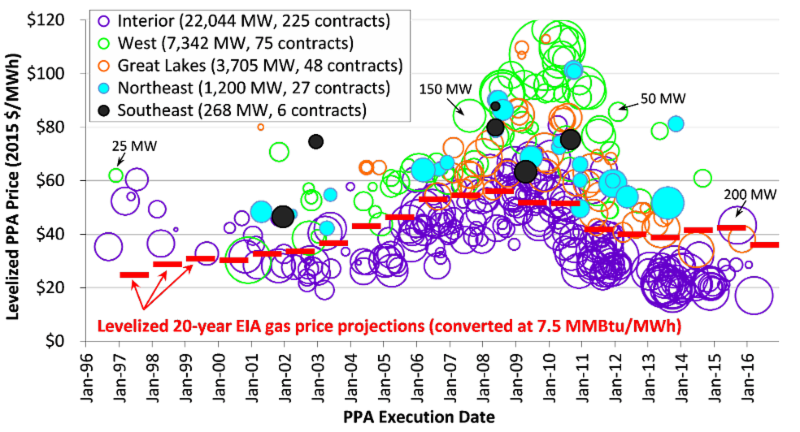
Figure 1. Wind Power Sales Prices vs. Natural Gas Fuel Costs in the United States
With such dramatic historical advancements, it is tempting to believe that the opportunity for significant additional cost reductions might be tapped out. Perhaps the technology has largely reached its limits, maturity has set in, and only small improvements are possible. Survey findings, however, and the broader academic literature suggest room for optimism, but also significant underlying uncertainties.
Survey Findings Are More Bullish than Much of the Broader Literature
As shown in the Nature Energy article, survey respondents anticipate cost reductions for land-based wind, on average, of 24% by 2030 and 35% by 2050 under a median or 'best guess' scenario. Costs could be even lower: respondents predict a 10% chance that reductions will be 44% by 2030 and 53% by 2050. On the other hand, under a 'high cost' scenario, survey respondents also note a 10% chance that costs will largely be in stasis to 2050.
These levelized cost of energy (LCOE) values are shown in Figure 2. The figure also presents the results of a literature review, summarizing 26 different recent estimates of wind energy cost reductions that originate from a diversity of government, academic, and industry sources.
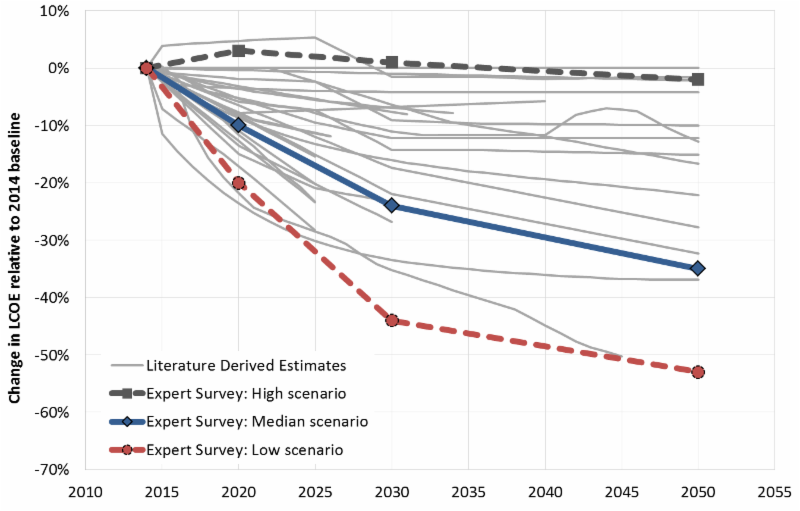
Figure 2. Estimated Change in LCOE over Time for Land-Based Wind: Survey Results vs. Other Forecasts
The 'cloud of uncertainty' over future wind energy costs is large, with a wide range of possible outcomes presented both by the survey and by the broader literature; to a degree, this motivates R&D to maximize the chance of achieving the lower-cost scenario. Reassuringly, the survey results largely span the values of the broader literature; of course, some of the same experts who responded to the survey also generated some of the other literature summarized in Figure 2, so perhaps this should come as no surprise.
Viewed in more depth, two additional conclusions emerge from this comparison.
First, most of the literature estimates (the grey lines in the figure) are more pessimistic than the 'best guess' or median result from the survey. Specifically, the median forecast from the broader literature shows an 11% LCOE reduction by 2030 and 13% by 2050, compared to 24% by 2030 and 35% by 2050 from the survey. Survey respondents are clearly more-bullish about the prospects for continued cost reductions than much of the recent literature.
Second, several reports from the U.S. Government are notably more pessimistic than the median-scenario from the survey. The U.S. EIA's Annual Energy Outlook, for example, shows the capacity-weighted wind LCOE (excluding tax incentives) increasing by 13% between 2018 and 2022 ($51.9/MWh to $58.5/MWh), before decreasing by 16% in 2040 (to $43.7/MWh). The U.S. EPA, in their assessment of the Clean Power Plan, seemingly predicts virtually no change in wind costs from 2016 to 2050. And finally, even the U.S. DOE Wind Vision study's 'mid-point' estimates of 16% reductions by 2030 and 22% by 2050 are more conservative than the survey results.
Though conservatism might be appropriate in some cases, and there are large uncertainties about future wind costs that must be acknowledged, one is still left with the view that the energy community may be under-estimating the potential for wind energy cost reductions.
Defending the Survey Results: Counterarguments to the Possibility of Bias
A skeptic might argue that the survey results are unreliable, perhaps prone to bias by only surveying individuals with a vested stake in the success of the wind sector or to other forms of inaccuracy. To a degree, a dose of skepticism is warranted: there is no way to directly test for bias, after all, and so expert elicitation findings might best be a complement to other approaches to understanding cost reduction.
That being said, two aspects of the survey results should offer some solace even for the skeptic.
First, though past performance is no guarantee of future results, the survey results are consistent with historical LCOE trends:
The 'learning rate' measures the decrease in cost for each doubling of cumulative production, and has been used extensively to understand past cost trends for a wide range of products, and to forecast future costs. As discussed later, the vast majority of learning rates used in the wind sector have focused exclusively on up-front capital costs.
Figure 3, however, presents the historical LCOE and calculated learning rates (LRs) for four estimates of LCOE; past land-based wind energy costs have declined by, on average, 10.5% to 18.6% for each doubling of cumulative capacity. The figure compares that to the survey results. More important than the absolute cost estimates from the survey (which represent, in effect, an averaging of U.S. and European costs) is the learning rate: the median survey estimates for LCOE reduction have an implicit learning rate of 14% to 18%, squarely in the range of past estimates.
Though learning rates can be controversial and should be applied with caution, the fact that survey results are consistent with historical LCOE learning provides some assurance that those results are within the bounds of reason. (Note how much longer it takes to reduce costs in the future than in the past; this is because each additional doubling of cumulative installations is progressively harder to achieve.)
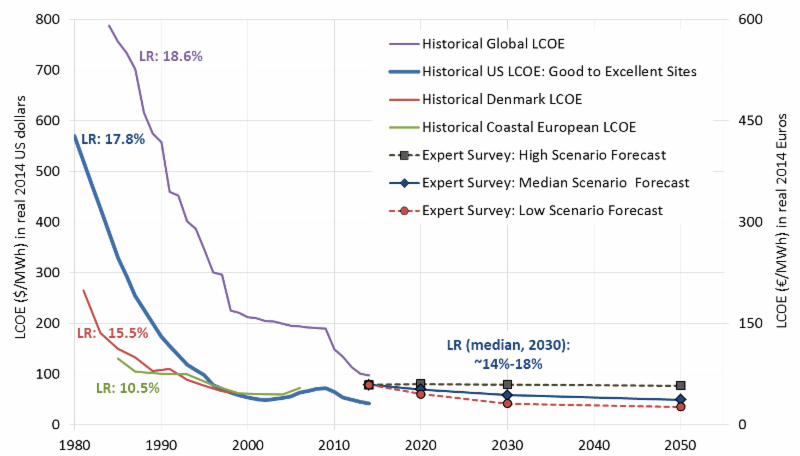
Figure 3. Historical and forecasted land-based wind levelized cost of energy and learning rates (LRs)
(The log-log learning rate formulation of this graphic can be found in the Nature Energy article)
Second, survey respondent views are broadly consistent across different respondent groupings, with 'leading experts' being even more bullish on the prospects for cost reduction:
The study investigated whether certain respondent groupings are more, or less, optimistic than others. In most cases, median responses were broadly consistent. Those working for wind developers or manufacturers expressed views generally similar to those working in government-funded research labs. And respondents with expertise in North America, Europe or other locations tended to have comparable views.
The single most-significant difference came from the so-called 'leading experts': a hand-selected group of 22 individuals who are among the wind sector's most knowledgeable and senior leaders. Those experts were, on average, even more optimistic about wind energy cost reduction, expecting LCOE to decline by 27% by 2030 and 48% by 2050 in the median scenario, and by 57% and 66% in the low scenario (Figure 4). The views of this group suggest even greater potential for cost reduction than noted earlier.
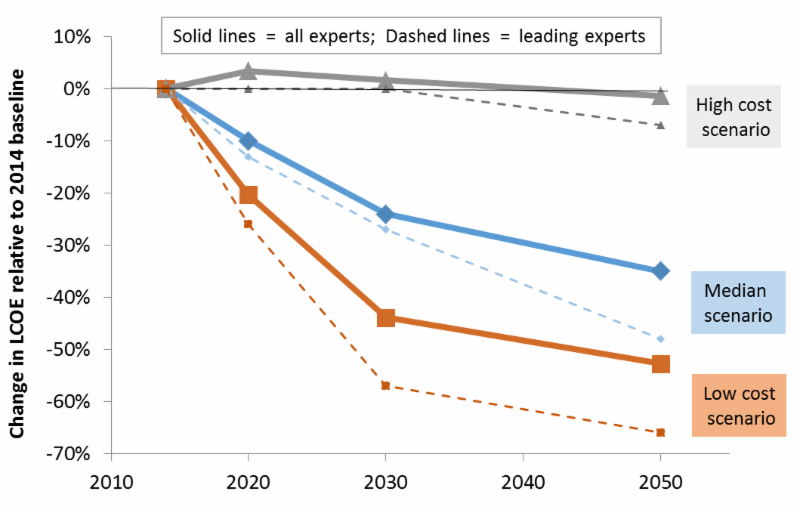
Figure 4. Expert Assessment of Future Costs: All Respondents vs. Leading Experts
The Why and How
Why might the survey results demonstrate greater potential for cost reduction than some of the existing literature? To some extent this may reflect an understandable desire for conservatism, especially among government prognosticators. More broadly, it may also reflect a misapplication, in some circles, of traditional learning rate calculations.
In particular, some of the past literature has focused primarily on reductions in the up-front cost (CapEx) of wind projects, with recently calculated historical learning rates of 6-9% when focused on CapEx. But the bottom line for the wind sector is not CapEx, it is LCOE. The DOE's Wind Technologies Market Report demonstrates very clearly that performance improvements, leading to higher capacity factors, have been a key trend in recent years. And this is, in part, why historical LCOE-based learning, shown earlier to be 10.5% to 18.6%, exceeds CapEx-only learning.
There are five key components that impact the LCOE: up-front capital cost (CapEx), ongoing operating costs (OpEx), cost of financing (WACC), performance (capacity factor), and project design life. As shown in Figure 5, survey respondents anticipate improvements in all of these cost drivers under the median and/or low-cost scenario, with the most impactful improvements coming from capacity factor increases and CapEx reductions. Forecasts that focus primarily on CapEx are missing at least half the story.
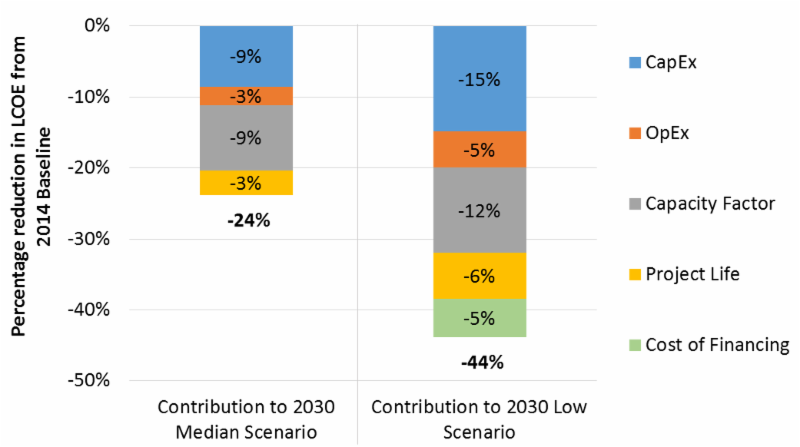
Figure 5. Relative Impact of Changes in Each of Five Components on LCOE in 2030
Implications and Uncertainties
To be clear, expert elicitations are only one means of gazing into the crystal ball. And, as with all other forms of prognostication, expert surveys have their limitations. Sadly, the energy community does not have a strong history of successfully predicting the future, a fact that the experts reflect in their wide range of responses. But two key implications emerge from the present work.
First, there is significant uncertainty about future wind energy cost reduction, illustrated by the range in expert views between the 'high cost' and 'low cost' scenarios shown earlier. The experts highlight deployment-oriented learning and wind R&D as the two most important enabling conditions likely to move us towards the low-cost scenario. An expansive range of possibilities exist, and those uncertainties deserve greater consideration in energy sector models, energy planning, and R&D decisions.
Second, the survey provides evidence that some notable models and forecasts may be understating wind's cost reduction potential. The findings from such models and forecasts may undermine planning and policy development, as well as private sector behavior.
If these implications are true, then we might not only be underappreciating the uncertainty in future outcomes, but also understating the potential role of wind in the future energy system and the contribution of R&D in enabling that future by moving us towards lower-cost scenarios.
Additional Information:
The survey was conducted under the auspices of the IEA Wind Technology Collaboration Programme. Berkeley Lab's contributions to this work were funded by the U.S. Department of Energy's Office of Energy Efficiency and Renewable Energy.
The Nature Energy article can be found here.
A full report on the survey findings is also available, as are presentation-style slide decks summarizing the results; a pdf version of this blog is also available. All of these files can be downloaded at the bottom of this page.
The content & opinions in this article are the author’s and do not necessarily represent the views of AltEnergyMag
Comments (0)
This post does not have any comments. Be the first to leave a comment below.
Featured Product

